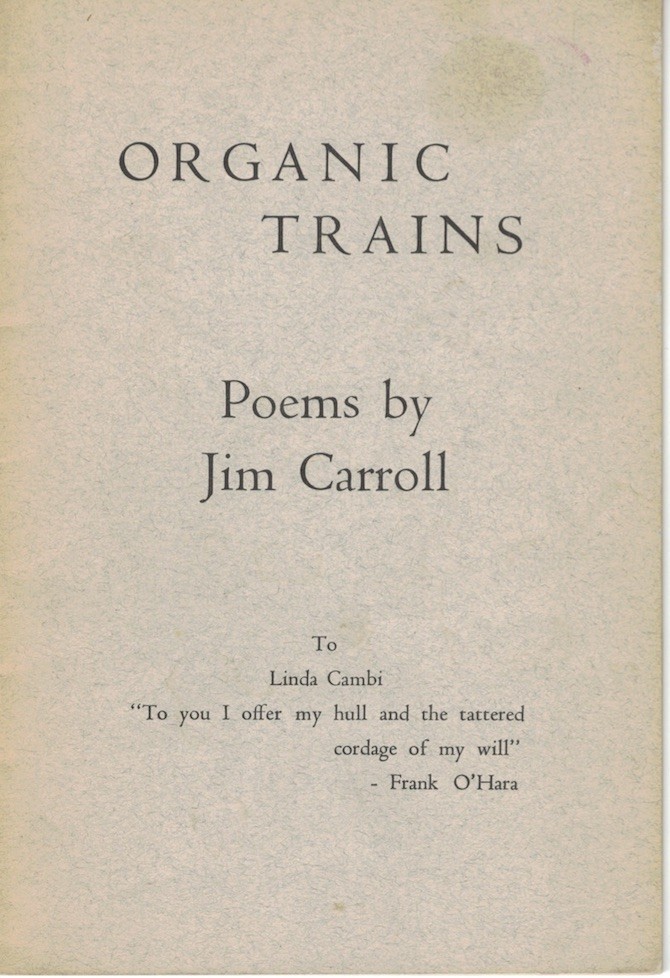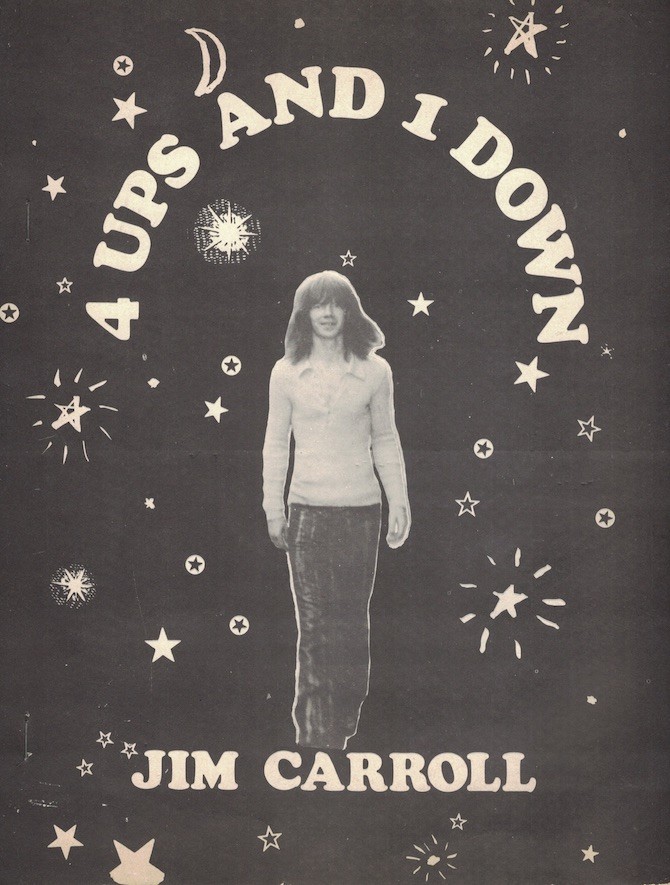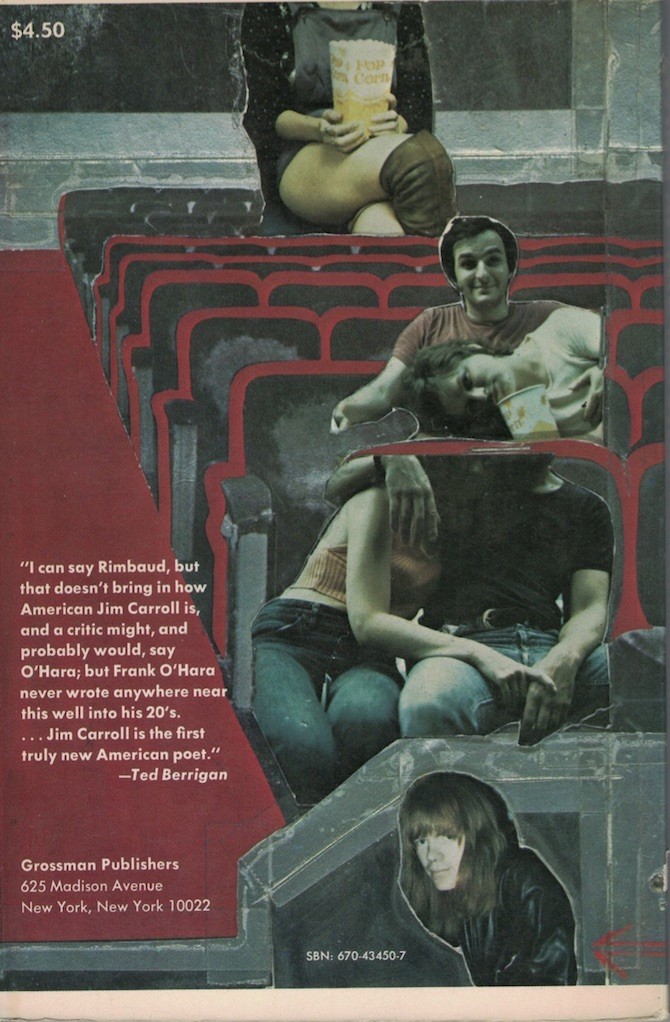Jim Carroll’s Living at the Movies
BY Vincent Katz

I’ve been thinking about Jim Carroll’s 1973 book of poems, Living at the Movies. A charming conspiratoriality lies at its heart, specifically that of a young person. This tendency, mixed with a visionary grasp of language’s possibilities, shifts these poems beyond what predecessors had envisioned, or at least had achieved. The heady combustion in Carroll’s poems makes them excellent markers of their time but also gives them a quality that extends beyond it.
When it came out, published by Grossman Publishers of 625 Madison Avenue, Carroll was 22. It was his first poetry collection. He’d previously published the chapbooks Organic Trains (Penny Press, 1967) and 4 Ups and 1 Down (Angel Hair, 1970). The latter contains five poems collected in Living at the Movies, while the former is made up of poems Carroll wrote, mainly on subways, while a high school student at Trinity School in New York; these were not included in Living at the Movies.
The book that put Carroll on the wider literary map, The Basketball Diaries, journals written while he was a teenager that imaginatively document his dissolute youth, was first published in 1978 by Tombouctou Press, based in Bolinas, California. But the publication of Living at the Movies had already created a sensation in the downtown poetry world. The buildup had begun with Carroll’s two chapbooks and public readings, as well as publication of sections of The Basketball Diaries in The Paris Review.
Carroll’s arrival as a poet was given an official imprimatur in Ted Berrigan’s blurb, which appeared on the Living at the Movies’ back cover:
I can say Rimbaud, but that doesn’t bring in how American Jim Carroll is, and a critic might, and probably would, say O’Hara; but Frank O’Hara never wrote anywhere near this well into his 20’s. ...Jim Carroll is the first truly new American poet.
This produced some grumbles and raised eyebrows among other poets at the time. As Berrigan moved from exaggeration to hyperbole, he seemed to have left critical judgement at the door. That may sometimes be where it should be left, particularly at those moments when someone is shifting, as Carroll was, between bizarrely different zones. Also, Berrigan’s comment appears in quotation marks, so maybe it should be taken more in the context of someone rambling on at a bar than as a critique published in a literary journal.
In any event, it is a useful jumping off point to think about Carroll’s poetry, bringing together Rimbaud, O’Hara, and Berrigan as touchstones. I will argue, and this may in fact support Berrigan’s statement to a degree, that Carroll, who went on to release three albums on Atlantic Records fronting The Jim Carroll Band and to thrive reading his ongoing memoirs on the spoken word circuit, actually missed his real calling, that of a poet. He continued to write and publish poetry but seems to have missed the point Berrigan was alluding to—that he was really a very fine poet, possessed of a precise ear and an assured sense of who he was at the moments he was writing. Maybe he thought he would always be golden, or that the party would never end. Or maybe there were so many signals it was inevitable they would get scrambled at some point. One thing is for sure: Jim Carroll should be recognized as a significant writer of original poetry, the core of it to be found in Living at the Movies.
*
Carroll grew up on the Lower East Side, descendent, his bio states, of three generations of bartenders. We should pause for a moment to consider what that might mean. No biography yet exists of Carroll, but there should be one. I, for one, would like to know more about his earliest years, that formative phase that is of the greatest interest in any biography. In the meantime, I take it to mean that Carroll grew up among raconteurs, and more, artists of the word. Some fraction of those were, whether they knew it or not, poets. I think of the Irish tradition in our American poetry, of O’Hara, Berrigan, Carroll, Eileen Myles, and Michael Lally. There are many more, but these for me form a core of poets who move from emotional talking to poetry in an easily accessible line—accessible for both poet and reader, or listener, as the Irish tradition is always very close to the aural, musical, aspect.
Carroll received a scholarship to Trinity School in Manhattan, and here I have some firsthand knowledge, as I too attended Trinity. My Latin teacher, Frank Smith, a formative and formidable influence, was teaching at Trinity when Carroll arrived. Smith remembered finding Carroll, on his arrival, a little out of sorts, disoriented among his new upper class classmates. Smith took Carroll aside, talked to him. He quickly recognized the obvious—that Jim was a poet. He started talking to him about poetry. Carroll began to feel at ease, to realize that behind the posh accents and stories of lavish weekend getaways, there was a core of seriousness at the school, a devotion to learning, and to literature, without which no one can become or remain a serious writer.
I wish I knew all they spoke of. I do recall one poem however—Matthew Arnold’s “Dover Beach.” Of all of Arnold’s poems, “Dover Beach” is surely the one that appeals most to poets of the New York School. I know a number of them got worked up over such lines as “The sea is calm tonight,” “the world, which seems / To lie before us like a land of dreams,” and of course, “Where ignorant armies clash by night.” We will see such breathlessness and fevered yearning reappearing transfigured in the poems of the young Carroll.
Jim was a basketball prodigy—at Trinity but also on the courts of New York City, where, he claimed, with probable veracity, that he added a shot to Lew Alcindor’s arsenal. There was a certain swagger to Jim, to his poems, his clothes, his rock ambitions, but there was also a sweetness, a soft-spoken delicacy that was genuine. I knew Carroll a little; he was always a perfect gentleman, taking the time to talk, wishing my parents well.
*
I am writing this essay partially to argue that the book itself is a work of art. The combination of the poems contained within, their sequence, the font chosen to print them in, the design of the interior, the cover design, the physical feel of the object, all contribute to the experience of this work of art. In the case of Living at the Movies, in its original edition, published in both hardcover and paperback, all these elements work together to create an ultimate poetic act.
On the book’s cover, designed by painter Larry Rivers, figures disport themselves in a format that wraps around from front to back. They are overtly artistic forms—photographs collaged onto a painted background of seats in a movie theater—and they are also recognizable figures: one being Carroll himself, an arrow making clear the indication. The others may not be immediately recognizable, but a little research reveals that Rivers used those around him, as was his wont, to people this imaginary ideal embodied in the concept of Living at the Movies.
Rivers’s son, Steven, appears on the back cover with a young woman, perhaps his girlfriend, along with another couple, whose heads are not visible. Larry’s girlfriend, Diana, is accorded pride of place on the front cover, performing the classic identification of eating and sex, with the implication that all life’s most important activities can, and do, take place in movie theaters. One remembers Pier Paolo Pasolini’s descriptions, as well as Frank O’Hara’s famous ode, “Ave Maria.”
This may be Rivers’s greatest work of art. Rivers was an important painter, especially for his large, multiple portraits of friends and family done in the 1950s in an affecting scumbling technique. But it may be in his friendships with O’Hara, Kenneth Koch, John Ashbery, and others that he left his most lasting legacy: in his classic lithographic poem collaboration with O’Hara, Stones (1960), in their collaborative text, “How To Proceed in the Arts,” and in his many portraits and book covers. For Living at the Movies, in particular, Rivers reached an inspirational height, his vision encompassing the book and the reader in just the way the darkness and ambience of a movie theater encompass the viewer, suggesting a precise admixture of mayhem, uncertainty, anticipation, and transport into another realm.
*
I don’t have space here for a full analysis of the book, so the analysis of one poem will have to suffice to illustrate my feeling that Carroll’s early poems are of a very high level and worthy of serious consideration.
In the first poem in the collection, “Blue Poles,” we are introduced to our narrator, who speaks in a halting fashion, spinning phrases out musically and with precise visual attention to the poem’s formal attributes, in this case nine two-line stanzas. We are also introduced to the narrator’s waywardness, another charming quality. As his thoughts move, sometimes glacially slowly, sometimes at breakneck speed, so do his affections. The book itself is dedicated to Devereaux, as is at least one poem, but there are many poems dedicated to other amours, one supposes, whether momentary or lasting, it doesn’t matter. Transience is part of the beauty of this book, countered by the lastingness of many of its lines.
Drugs are an essential through line in Living at the Movies, particularly drug imagery, not only in such phrases as “shooting up,” which recurs often enough to qualify as a theme, or “horse(s),” but the use of such modifiers as “tiny.” Things are seen through particular lenses in these poems, and sound, as well as silence, is precisely registered. The sensual qualities enlisted here evoke a poetic headspace unlike any other from that period of the late ’60s and early ’70s.
“Blue Poles” begins “on the beach.” Which beach is not specified (might “Dover Beach” have been in Carroll’s mind?), but it is in significant distinction to the city. Physical location in Living at the Movies is never so clearly marked as it is in the poems of O’Hara or Berrigan. There is a more metaphysical tone to Carroll’s poems, something again that stands his poetry apart from that of many of his friends and contemporaries. He uses line breaks with deadpan dramatic precision. “Blue Poles” begins:
Blue poles (well?) on the beach
in a snowless winter and
I’m too cold to ask you
why we’re here but of course “we are”
I’ve long pondered that “well?”, so etched is it in my memory, but I still have no clear explanation for it, especially coming so early in the poem, so early in the book. I know Jackson Pollock’s painting Blue Poles, which is probably the springboard for the question. But is there something more? Maybe “blue poles” is a drug reference? Maybe sexual? “A snowless winter” brings to mind another New York School poet, James Schuyler, and his poem “A White City”:
My thoughts turn south
a white city
we will wake in one another’s arms.
I wake
and hear the steampipe knock
like a metal heart
and find it has snowed.
The everyday language in the second stanza of “Blue Poles” flows free of slang; it is simply the normal way anyone might speak, which makes the ending (“but of course ‘we are’”) that much more impactful. It is a normal occurrence, two people at the beach, albeit in cold winter, but there is something beyond the normal.
That something is revealed in the fifth and sixth stanzas. Before that, we find packed lines that are hallucinatory without being surrealist, a major accomplishment in my opinion:
where on the puzzled reef dwarves either
fish or drown in the abandoned ships
sharks dissever year-old children in search
of “young blood” Jersey acting like Europe
There is a compression going on here that encourages one to read “puzzled reef dwarves” together, in tension with the syntactical thrust of those words in the implied sentences of the poem. Implied, because Carroll’s poems are not usually in complete sentences; he likes to work with this tension between syntax and imagistic word clusters. “Dissever” is an Elizabethan-sounding word Carroll might have picked up from Berrigan’s use of it in The Sonnets, first published in 1964 by the poet’s own C Press. In “Poem in the Traditional Manner,” Berrigan writes:
Whenever Richard Gallup is dissevered,
Fathers and teachers, and daemons down under the sea,
Audenesque Epithalamiums! She
Sends her driver home and she stays with me.
It is an odd word, essentially meaning “sever,” the variation chosen by Berrigan for rhythm. There is a Shakespearean undertone to The Sonnets, which is no longer present in Living at the Movies. Carroll also pays attention to the word’s meaning, whereas Berrigan uses it more for theatrical effect.
“‘Young blood’ Jersey acting like Europe” has always been a favorite line, first because it introduces a street-smart look in the phrase in quotes that Carroll normally stays away from in these poems (the narrator himself being street smart, the words don’t have to be). I like the way Jersey, being put into contest with Europe, can be the continental landmass close to but far from New York and also the British island, close to the coast of France and that shared history of animosity. The paucity and opacity of his references combined with his contemporary language gives Carroll’s poems a smooth surface and an elegant style.
“In an instant and lovely,” Mary, in the third person (is she the same person who was “you” in line three?) appears as the major romantic, or at least sexual, interest in this poem. Yet, this is no piece of easy erotica. Carroll’s poems are very erotic, but their eroticism is based on shifts from frankly sexual imagery to language that is Romantic, unexpected, and distancing. Sex is alluded to, or described, in instantaneous flashes that recede from view as quickly as they appear.
“Anxious with the thoughts of bare” you might expect “breasts”? No, Carroll gives you instead “oceans”. “Oceans / that move as the thighs” you are expecting something explicit? Not exactly. Rather, “the thighs of an eventual sunlight.” That is sexy in itself, because the word “thighs” in this context, at the beach, in the cold, is sexy, and in a way, even sexier, because the reader is led to an unexpected place, a place of “eventual sunlight / like bathers moving closer to their season” (an unusual and effective use of simile).
We feel the poem moving to a climax, and it does, through rhythms set up in the penultimate and antepenultimate stanzas: “gulls perch” (another cluster), “their lovely confusion” (an erotic term with an unerotic noun), “the sand sifting”, “like another’s darkness” (a Romantic image). The ending, in its frankness, functions almost like a punchline: what may have been expected all along finally does arrive, but now that it is happening, it happens on its own terms, and one has to smile.
*
I believe Carroll was a poet at heart; he got swept by many currents, temptations and thoughts about career, or to put it more colloquially, what was hip to do or be, and perhaps he was knocked off his poetry axis. He continued to write poetry and always remained capable of crafting a successful piece, but he did not exhibit a huge amount of growth as a poet. Something in the art form confounded him; it’s tragic in a way, as the poems in Living in the Movies show flashes of excellence, and they are totally cool in themselves, they wear their limitations proudly. They are excellent and simultaneously the promise of a future beauty. That Carroll was not able to move beyond this as a poet is reason to wonder what might have been. He did move on; he wanted fame, and he found it. Hopefully, that was nourishment enough.
Vincent Katz is a poet, translator, curator, and critic. He earned his BA from the University of Chicago...
Read Full Biography




